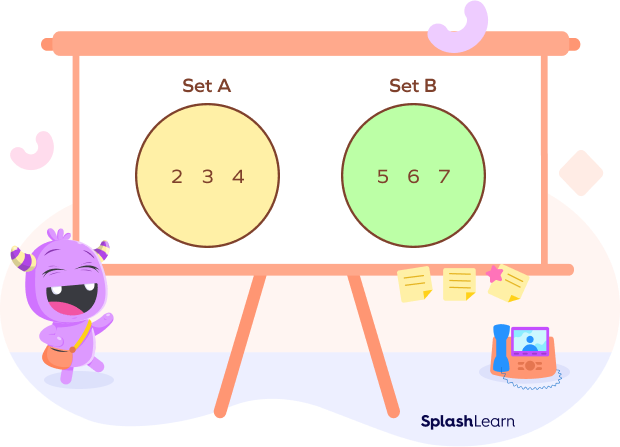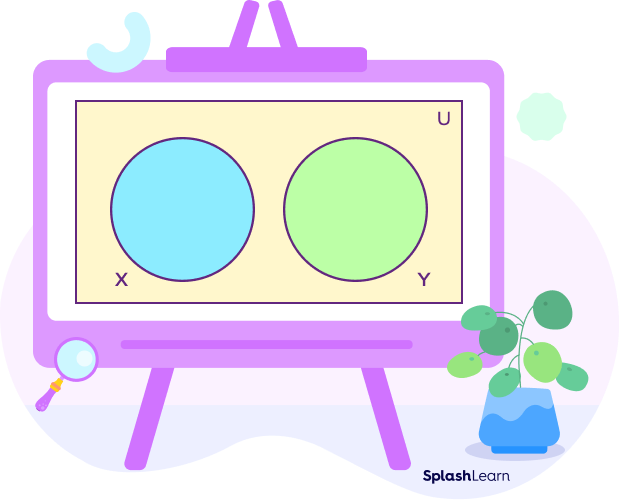What Are Disjoint Sets?
Disjoint sets are two sets that have no common elements. In other words, their intersection is the empty set.
What does disjoint mean? The term disjoint simply means “not connected.” So, disjoint sets are the non-intersecting sets; they have no elements in common.
Example 1: Consider two sets:
A = {2, 3, 4}
B = {5, 6, 7}
There is no element common in both sets. A ∩ B is the empty set. Thus, we can say that the sets are disjoint.

Example 2: P = {0, 1, 2} , Q = {1, 2, 3}
P and Q are not disjoint since P ∩ Q = {1, 2} $\neq$ ∅
Recommended Games
Disjoint Sets Definition
In set theory, two sets are called disjoint if the intersection is the empty set or null set.
A and B are disjoint sets if and only if A ∩ B = ∅.
A collection of two or more sets is said to be disjoint if the intersection of every pair in the collection is an empty set.
Recommended Worksheets
Disjoint Sets Venn Diagram
Disjoint sets can easily be determined using a Venn diagram. Venn diagram shows how sets are related to each other, and it also helps to understand different operations on the sets.

Pairwise Disjoint Sets
A collection or family of sets S is said to be pairwise disjoint if the intersection of every pair of sets in the collection is the empty set. It is also called mutually disjoint sets.
𝑋 ∩ 𝑌 = ∅ for X, Y ∈ S and X ≠ Y
How to Find if Two Sets Are Disjoint Sets
To assess if two sets are disjoint, we must find the intersection of the two sets. If the intersection result is empty, then the sets are disjoint.
Example:
M = {0, 1, 2}
N = {2, 3, 4}
O = {4, 5, 6}
Now, by intersecting each pair of sets, we gain
M ∩ N = {0, 1, 2} ∩ {2, 3, 4} = {2};
N ∩ O = {2, 3, 4} ∩ {4, 5, 6} = {4};
M ∩ O = {0, 1, 2} ∩ {4, 5, 6} = ∅
As a result, the sets M and O are disjoint sets.
Note:
Here, the joint intersection of three sets is the null set (M ∩ N ∩ O=∅), but the three sets are not disjoint. It is because every pair within the group is not disjoint.
Facts about Disjoint Sets
- Partition of the larger sets can be done through disjoint set theory. It helps to separate larger sets into non-overlapping or smaller subsets.
- The empty set is disjoint with itself.
- The empty set is the only set that is disjoint with itself.
- The empty set is disjoint from every set.
- A group of sets may have a null intersection without being disjoint. For example, the three sets {a, b}, {b, c}, and {a, c} have a null intersection (the joint intersection of three sets is empty), but they are not disjoint. No two sets in this group are disjoint.
Conclusion
In this article, we learned about disjoint sets, important definitions, and how to find disjoint sets with examples. Let’s recall these concepts and solve a few examples and practice problems.
Solved Examples on Disjoint Sets
1. Find out if the given set P = {2, 4} and Q = {4, 5} are disjoint.
Solution:
P = {2, 4} and Q = {4, 5}
P ∩ Q = {2,4} ∩ {4, 5}
P ∩ Q = {4}
P ∩ Q ≠ ∅
Since the intersection of P and Q is not empty, the given two sets are not disjoint sets.
2. A = {a, b}, B = {2, 3) and C = {c, d}. Find the disjoint sets.
Solution: Given:
A = {a, b}
B = {2, 3}
C = {c, d}
To determine the disjoint sets, we will calculate the intersections of the given set:
A ∩ B = {a, b} ∩ {2, 3} = ∅
B ∩ C = {2, 3} ∩ {c, d} = ∅
A ∩ C = {a, b} ∩ {c, d}= ∅
Thus, as per the intersection analysis, all three sets show a null intersection. Therefore, sets A, B and C are disjoint with each other.
3. A = {Earth, Jupiter}, B = {Pluto}, C = {Mercury, Venus}. Prove that A, B, and C are disjoint sets.
Solution: Given:
A ∩ B ={Earth, Jupiter}∩{Pluto} = ∅
A ∩ C ={Earth, Jupiter}∩{Mercury, Venus} = ∅
B ∩ C ={Pluto}∩{Mercury, Venus} = ∅
Each pair is disjoint. Thus, the sets A, B, C are disjoint sets.
Practice Problems on Disjoint Sets
Disjoint Sets: Definition, Symbol, Facts, Examples, FAQs
A = {0, 2, 4, 6, …} , B = {1, 3, 5, 7, …}
The set A is the set of even numbers. The set B is the set of odd numbers.
They have no element in common. They are disjoint.
What is the intersection of disjoint sets?
The intersection of disjoint sets is the null set ∅.
A/An _____ is disjoint with every set.
An empty set is disjoint with every set.
Sets P and Q are disjoint sets if
Sets P and Q are disjoint sets if the intersection of the two sets is a null set, P ∩ Q = ∅.
Frequently Asked Questions on Disjoint Sets
Is the empty set disjoint with itself?
Yes, the empty set is disjoint with itself.
What is the cardinality of A B if A and B are disjoint ?
n(A B) = n(A) + n(B) – n(AB)
If A and B are disjoint, n(AB) = 0
Thus, n(A B) = n(A) + n(B) if A and B are disjoint.
What are mutually exclusive events in probability?
In probability theory, two events are said to be mutually exclusive if they cannot occur simultaneously (P(A $\cap$ B) = 0). They are also called disjoint events.



















